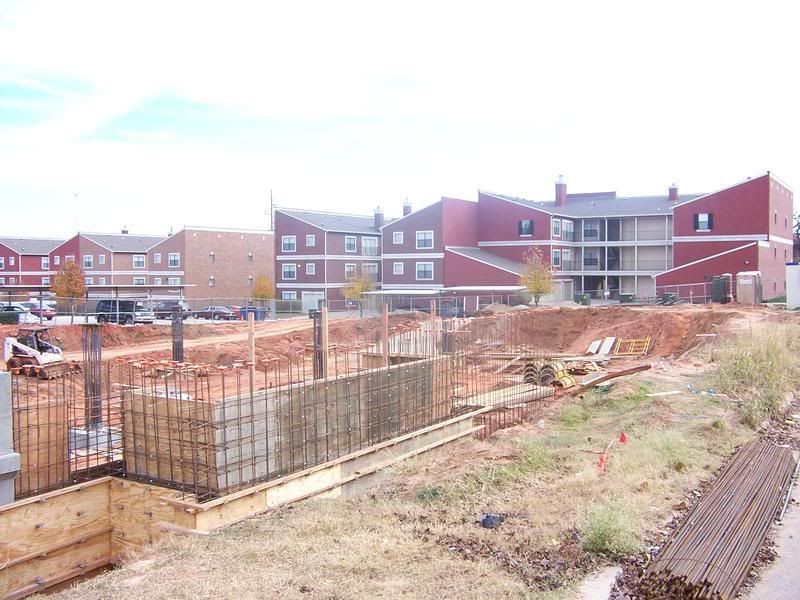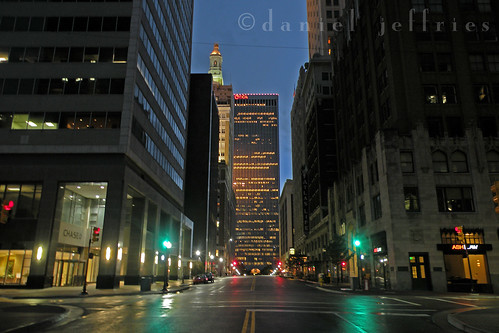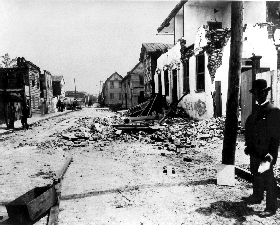So in this post we'll examine OCURA's stellar track record in advancing "quality" urban development in OKC.
 I think we can all appreciate the corrupt bidding process in which we ended up with Bass Pro, over other potentially more urban projects that had been pitched. The good news is that Bass Pro is virtually the extent of retail in Bricktown, and the rest of downtown. It also added something Bricktown was in desperate need of: surface parking. So all in all, a win-win. Plus the adjacent Lower Bricktown development was absolutely fool-proof. Even though The Centennial is the only remotely urban component of Lower Bricktown, even it is loosing retail tenants. (LiT went out of business.) LB's other clothing retailer, Firefly Clothing, also closed recently. So one bright spot for Lower Bricktown, the fact that it did at least have leasing, is now just one of many sore spots for the much-maligned project. Add to the fact that LB has never been finished, and likely won't ever be finished until the Crosstown comes tumbling down and replaced by an at-grade boulevard behind Lower Bricktown. As it happens, developers Stonegate Hogan were given a TIMELINE on the project, and the TIMELINE has since lapsed. Will OCURA ever close on the remaining canal-front land and take it back, and try and get some other developers to bid on it? Nah, never. This is not about good development, the City of OKC, protecting a public investment like the canal, or ANYTHING like that. This is about the good ol' boy system and pushing the interests of the developer, Stonegate Hogan.
I think we can all appreciate the corrupt bidding process in which we ended up with Bass Pro, over other potentially more urban projects that had been pitched. The good news is that Bass Pro is virtually the extent of retail in Bricktown, and the rest of downtown. It also added something Bricktown was in desperate need of: surface parking. So all in all, a win-win. Plus the adjacent Lower Bricktown development was absolutely fool-proof. Even though The Centennial is the only remotely urban component of Lower Bricktown, even it is loosing retail tenants. (LiT went out of business.) LB's other clothing retailer, Firefly Clothing, also closed recently. So one bright spot for Lower Bricktown, the fact that it did at least have leasing, is now just one of many sore spots for the much-maligned project. Add to the fact that LB has never been finished, and likely won't ever be finished until the Crosstown comes tumbling down and replaced by an at-grade boulevard behind Lower Bricktown. As it happens, developers Stonegate Hogan were given a TIMELINE on the project, and the TIMELINE has since lapsed. Will OCURA ever close on the remaining canal-front land and take it back, and try and get some other developers to bid on it? Nah, never. This is not about good development, the City of OKC, protecting a public investment like the canal, or ANYTHING like that. This is about the good ol' boy system and pushing the interests of the developer, Stonegate Hogan. One of the few bright spots, if you're one of them out-of-touch urban advocates, is the Deep Deuce Apartments--but even Deep Deuce has one glaring downfall: it was NEVER completed, and won't EVER be completed as planned. So it's another example of where a developer proposes one thing, gets the bid, then does the ole switcharoo or doesn't even come close to finishing the development that they said they would do. Never mind the fact that the reason they were given the bid was to do the development they proposed, and nothing else. Integrity is not an important factor here, because OCURA doesn't actually care about "urban renewal."
One of the few bright spots, if you're one of them out-of-touch urban advocates, is the Deep Deuce Apartments--but even Deep Deuce has one glaring downfall: it was NEVER completed, and won't EVER be completed as planned. So it's another example of where a developer proposes one thing, gets the bid, then does the ole switcharoo or doesn't even come close to finishing the development that they said they would do. Never mind the fact that the reason they were given the bid was to do the development they proposed, and nothing else. Integrity is not an important factor here, because OCURA doesn't actually care about "urban renewal." Funny thing about the Overholser Green project is that I actually defended OCURA here. I supported the Overholser Green project because it was a good project, and at the time, I didn't realize how it was financially unfeasible. The high-end nature of the project, especially the condominium aspect. In contract to Marva Ellard's competing proposal, a mixed-use project with rental residential and financing in place. Well it's obvious that OCURA couldn't have picked that project, because it actually had a relatively good chance of success. That would just completely throw OCURA's track record all out of whack. Now where we are is (3/4 years or so after the bid was awarded) Chuck Wiggin has stalled on the project. In fact he scaled it way down so that it was a much less significant project, and he still couldn't get it off. So basically after he was awarded the contract, he pulled the old switcharoo as so many of them do, and instead of pulling the contract AS OCURA SHOULD HAVE DONE, OCURA approved it again because they already awarded the contract. At that point and thereafter Wiggin could have done whatever the hell he wants, or doesn't want; he could have put a 7/11 on that land for all OCURA cared. The story more or less has been marked by what he doesn't want to do, and that is develop the land which has absolutely sat there and won't be developed any time soon. Thanks to everyone's favorite gub'ment agency.
Funny thing about the Overholser Green project is that I actually defended OCURA here. I supported the Overholser Green project because it was a good project, and at the time, I didn't realize how it was financially unfeasible. The high-end nature of the project, especially the condominium aspect. In contract to Marva Ellard's competing proposal, a mixed-use project with rental residential and financing in place. Well it's obvious that OCURA couldn't have picked that project, because it actually had a relatively good chance of success. That would just completely throw OCURA's track record all out of whack. Now where we are is (3/4 years or so after the bid was awarded) Chuck Wiggin has stalled on the project. In fact he scaled it way down so that it was a much less significant project, and he still couldn't get it off. So basically after he was awarded the contract, he pulled the old switcharoo as so many of them do, and instead of pulling the contract AS OCURA SHOULD HAVE DONE, OCURA approved it again because they already awarded the contract. At that point and thereafter Wiggin could have done whatever the hell he wants, or doesn't want; he could have put a 7/11 on that land for all OCURA cared. The story more or less has been marked by what he doesn't want to do, and that is develop the land which has absolutely sat there and won't be developed any time soon. Thanks to everyone's favorite gub'ment agency. No downtown project exemplifies "FAILURE" like The Hill does, and that's bragging rights nobody can even come close to. This is the kind of project that OCURA really hangs its hat on, the bread and butter of what OCURA is all about as a corrupt government agency. I guess first you gotta begin with the corrupt bidding process, against two other more financially feasible projects, including a great mixed-use proposal from Anthony McDermid. Within the last 12 hours before the bid was awarded, Bill Canfield and Marva Ellard (developers of The Hill) notify OCURA that they're dropping their request for a TIF district as a part of the development. OCURA was legally required to notify McDermid and others of the change in the competing proposal, but failed to do so because it was late at night. McDermid later said that had he been notified, he also would have dropped his request for the TIF--but never got such a notice. Now that The Hill is what we're stuck with, as it's already under construction, it's become even more of a quagmire. The suburban design of the over-priced units have scared away any potential buyers, so the project has sold only 2 or 3 units, total. Without selling ANY units, Canfield couldn't pay contractors, so they stopped construction and probably hold liens on the project. The project can't even be closed on and reclaimed by OCURA at this point, because the few dozen townhomes that were built (out of 160 or so proposed) use up ALL of the street frontage that this project has. The only way thing that could be put on that site now is a big box retailer that needs highway visibility more than frontage (like BASS PRO, hint hint), or a commuter parking lot. That's it.
No downtown project exemplifies "FAILURE" like The Hill does, and that's bragging rights nobody can even come close to. This is the kind of project that OCURA really hangs its hat on, the bread and butter of what OCURA is all about as a corrupt government agency. I guess first you gotta begin with the corrupt bidding process, against two other more financially feasible projects, including a great mixed-use proposal from Anthony McDermid. Within the last 12 hours before the bid was awarded, Bill Canfield and Marva Ellard (developers of The Hill) notify OCURA that they're dropping their request for a TIF district as a part of the development. OCURA was legally required to notify McDermid and others of the change in the competing proposal, but failed to do so because it was late at night. McDermid later said that had he been notified, he also would have dropped his request for the TIF--but never got such a notice. Now that The Hill is what we're stuck with, as it's already under construction, it's become even more of a quagmire. The suburban design of the over-priced units have scared away any potential buyers, so the project has sold only 2 or 3 units, total. Without selling ANY units, Canfield couldn't pay contractors, so they stopped construction and probably hold liens on the project. The project can't even be closed on and reclaimed by OCURA at this point, because the few dozen townhomes that were built (out of 160 or so proposed) use up ALL of the street frontage that this project has. The only way thing that could be put on that site now is a big box retailer that needs highway visibility more than frontage (like BASS PRO, hint hint), or a commuter parking lot. That's it. We got LUCKY with this project. Here's another one where a developer (Mike Henderson) gets awarded a bid, based on a great proposal with snazzy architectural elevations..then he pulls the old switcharoo and we get Plainville. This project in no way resembles the high-design development that was anticipated during the bidding process. But the bright side is this: the project actually is URBAN, it's not necessarily UGLY, and it works. It also has 300 or so upscale rental units, and that's GREAT for downtown. OCURA accidentally stumbled upon a success here..but they should have held Henderson to his original design proposal, especially considering he got TIF funding for this. That's a public investment that OCURA should have been looking out for.
We got LUCKY with this project. Here's another one where a developer (Mike Henderson) gets awarded a bid, based on a great proposal with snazzy architectural elevations..then he pulls the old switcharoo and we get Plainville. This project in no way resembles the high-design development that was anticipated during the bidding process. But the bright side is this: the project actually is URBAN, it's not necessarily UGLY, and it works. It also has 300 or so upscale rental units, and that's GREAT for downtown. OCURA accidentally stumbled upon a success here..but they should have held Henderson to his original design proposal, especially considering he got TIF funding for this. That's a public investment that OCURA should have been looking out for.I could go on. The funny thing, as you read through the annals of downtown history and come across a chapter on Sycamore Square, is how we have literally repeated the Sycamore Square fiasco over and over and over and over in the last 5 years. Yes, it's true that downtown development has been booming, very successfully, in the last 5 years. There is a HUGE exception to that however, and that is any time OCURA is involved. OCURA stands for Oklahoma City Urban Renewal Authority, but I would seriously question, based on their track record, what the hell their problem is. I think here is a great example of where a government agency with a long acronym no longer comes even close to representing what its acronym stands for. So next time someone asks, "What does OCURA stand for?" The answer of course must be, "OCURA stands for O-C-U-R-A," not anything relating to urban or downtown or the community or anything like that.
Sadly, I think I could raise some very critical questions of Downtown Design Review these days, as well.















